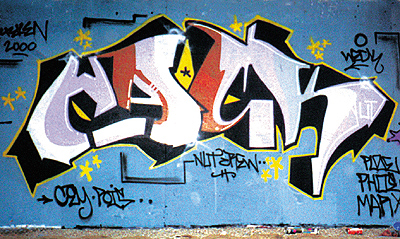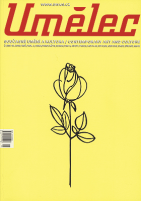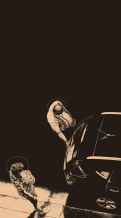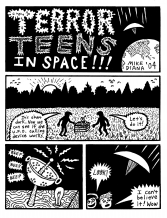| Zeitschrift Umělec 2000/4 >> On Beats, Rhymes, Prague Walls and Life | Übersicht aller Ausgaben | ||||||||||||
|
|||||||||||||
On Beats, Rhymes, Prague Walls and LifeZeitschrift Umělec 2000/401.04.2000 BLN | focus | en cs |
|||||||||||||
|
"Hip hop is an autonomous subculture with its own image, growing as a means of expression in ghettos. The music itself (whose roots go back to Jamaica’s toasters, or MCs, in the 1960s, James Brown and George Clinton; Afrika Bambaata claims he was influenced by Kraftwerk’s electronic music) is only one part of an extended subculture sharing space with graffiti art, breakdance, and rap. Like punk, as a product of youth’s revolt against the establishment, this subculture has proved to be a living, vibrant force, which has exploded out of the South Bronx, effectively ceasing to be only part of the black “minority.” Indeed, it has now been accepted in completely different backgrounds. Hip hop has significantly affected the overall esthetic outlook, but it is clear that on a mass level it is about consuming formal attributes.
With a slight delay, hip hop culture made it to this region after the political situation changed. In 1984 Lesík Hajdovský made the first rap song in this country, influenced by New York, New York by Grandmaster Flash. Jižák, Jižák, město snů… was made using a loop on a tape recorder. Ten years later, Rock & Pop magazine presented a brief survey of the history of rap and hip-hop compiled by several journalists. Looking at the list of local bands that were formally involved in the movement, we found a mix of mainstream and promising projects: Manželé (Lesík Hajdovský), Piráti, JAR, Miloš Skalka a Jakub Jakoubek, Rapmasters, WWW, Peneři strýčka Homeboye. A wide assortment of flavors. A few compilations presenting hip hop and related styles may also give you a better picture of the local scene. In 1996, the compilation Real Acid Juice was released (Coltcha, Peneři, WWW, United Heads—i.e,. mostly hip-hop but also one jungle track), followed by BMG’s Hip Hop Hurá and Terrorist?rec’s East Side Unia in 1998 (a compilation of hip-hop from Poland, Hungary, Slovakia and Bohemia, represented by Coltcha and Peneři). In 1999 Sony published a remix album by Manželé, which included hip-hop remixes by Coltcha, Trosky, WWW, Peneři, and Strictly Orange plus remixes by Blow, Skyline, Ecstasy of St. Theresa, and Švihadlo. The following interview was an attempt at looking at the local scene through the eyes of the people who were there at the beginning and who gradually moved on to other activities, and a writer who understands recent developments. Honza Zajíček, and Ondřej Anděra both began painting at the beginning of the 1990s and established the hip hop project WWW; they currently study animated film at FAMU. Richard Mokráš, or Sure, from the band Coltcha, painted in the mid-1990s (together with his wife Lela). Both are now parents. DJ Ali started spinning records in 1994 while studying in high school; in addition to DJing he also cooperates with Coltcha and Indy & Wich. MC Strictly Orange appears in United Heads, Skyline, T-Break… Wladimir 518 is a writer who is familiar with the Czech hip-hop scene and is co-publisher of the magazine Terrorist?, which covers the development of the local scene (the magazine also published the compilation East Side Unia), and is a member of Peneři strýčka Homeboye. Is there anything like a Czech hip hop scene? Honza: I don’t know if I can define what it is. But it does exist. Ondřej: It seems like it doesn’t exist. It’s a very small community of people. But there have definitely been a few things that have grown from common ground. Hip hop is an authentic form of urban folklore, originally transplanted from somewhere else, but in this specific environment it takes on completely new content. I have a feeling that most people see only the style of music under the term hip hop rather then a lifestyle. Ondřej: Perhaps it’s because people who do it don’t really show off how much they live hip hop, but that doesn’t mean that’s not the case. What does hip hop mean to you? Richard: Hip hop is just tracks and texts and a beatbox and it’s all just wicked! Ondřej: I can’t believe 90% of the music that’s made. Then this guy from Siberia comes over and to me he’s hip-hop too because you feel he’s for real without showing off too much. When you start using simple and comprehensible means and you make something interesting, it’s always going to be picked up by people who are driven by completely different reasons and intentions. In the end there are music stations full of the worst shit and some people still think it’s hip-hop. Do you think there is room to develop? Honza: I believe that the hip hop beat will go on. Ondřej: What I think can still attract people is coming up with an absolutely individual form without any inspiration. I appreciate the bands that are doing hip-hop here—Coltcha, Peneři, one band from Ústí, Indy and Wich, but I think there is room for development. On Graffiti The first graffiti began popping up in Prague at the beginning of the 1990s. A few pieces of information in the media precipitated its emergence: an article in the magazine 100+1, an MTV video, a book on New York graffiti from the 1970s and 1980s, films like Stylewars (a documentary on New York), Beatstreet and Wildstyle. As soon as the borders opened up, foreigners started pouring in; the first tags popped up. Rake/Sherys started painting and the CSB crew (Boob, Scum) was formed at about that time. It was still a small community of about 10, 15 people (Sifon, Lela, Mascee and Chise, Rich, Roof, WHF, Dede, Timothy, Maniak). The first graffiti jam was in 1991 at the club 007; the following year the event moved to Opatov (a WWW concert). The TCP crew was established (Scarf, Coby, Rake, Scum, DeLa Rock). Prague got its first wholecar and graffiti appeared in Kampa, Těšnov and Jižní Město. In 1993 the third graffiti jam took place at a club in the Main Train Station. This is a short history of graffiti genesis in the Czech Republic. Meanwhile the Prague scene gained an exclusive position. Together with a few cities in Germany, Prague is perhaps the only place in Europe where graffiti is chiefly about communication through shapes, still linked to the original idea of the New York graffiti of the 1980s. The local scene puts out the magazine Terrorist?, which has a reputation and is appreciated abroad. The people however changed within the scene. The effort to get rid of graffiti was all that was left unchanged. Graffiti is very difficult to define. You can point out certain formal attributes but as soon as you attempt to interpret the content of graffiti, it will always wind up being a subjective evaluation depending heavily on the particular person’s attitude towards graffiti. The phenomenon could be defined as vandalism, a forceful intervention into public space or a completely legitimate need to respond to the space, to inject energy into a city’s grayness. Discovering a new shape for a sign—type, name—may be perceived as a return to the roots. A graffiti writer understands the work’s frailty and knows that this work results in no financial gain. What was the original impetus that made you do graffiti? Honza: I started painting in about 1992 when the first tags started showing up in Prague and people from Berlin and France were coming here. I was astonished by graffiti’s novelty, ferocity; it was something I could identify with. I think other people experienced the same feelings, like Elvis, my classmate from Hollar Graphic Highschool. In 1993, TCP and I painted the first whole metro train. It was an adventure for us. Wladimir: When I was starting a few people had already painted here, setting the standard quite high. It was a challenge. I really appreciate people like Honza. At that time he was famous, like a pornstar, people wrote letters to him and they wanted to meet him. This French guy was hitchhiking through Hostivice in 1991, and he made a few tags there. He then got invited to the Stalin space, and he painted the walls. I went to the movies, saw the tags and was complete amazed. I started painting in 1994 when I found some space in Dejvice where a few exhibitions and events took place. In 1997 we organized the first bigger event—Kick the Shit at the club Roxy. It was great to see everything coming together there: music, breakdance, and painting. Most of you no longer do graffiti, but you go on making music. Were you not able to find any way for graffiti to develop further? Richard: Well, we did a few naive walls in Prague. But that’s history. Ondřej: I think everybody here would say that it’s ancient history. For me to. When I was starting in 1990 there was nobody else. For me it was the only way to come to understand something that nobody has done—that’s what interested me. I had to go through this stage of doing just letters and coming to understand why the classic form looks the way it looks. Suddenly, when you grasp that, you realize that you want to move ahead. In this sense, it is history for all of us but the direction is still valid. For example, Harring and Basquiat started out in classic graffiti and each of them went on in different directions. Basquiat found out that he just needed time to do his stuff, which is impossible to do when combined with the risk you run making graffiti. Harring used the principle of simplifying, creating the widely comprehensible sign language taken away from graffiti and he was able to tell stories with these signs. Each of us just shifted somewhere else. Graffiti is still the foundation for me, though. When I started doing film, I found out that there was a direction nobody had tried yet, which is the fusion of live acting, animation and special effects, and that, as with graffiti, I had to once again find a new language. It’s still the same blood; you just grab different tools. I’m 25 now and I’m not willing to get arrested for painting an underground train. If I come up with something ingenious, why the train should go and carry a message that would simply freeze the 100 people milling on the platform who would leave with some kind of feeling, then it might be worth it. But I don’t feel the need to have an esthetically rendered tag somewhere. But it’s cool that such records still exist as a part of the city. Honza: The basic problem is that there’s something egotistical inherent within it. That’s why it just doesn’t work. I perceive it as inflicting. Strictly: A city itself is an incredibly egotistical thing, so it’s fine. Honza: But you can never bow to this. Strictly: A city is an egotistical thing and making graffiti is just the same as building cities. In my view, this is a perfectly natural means of expression for city people… Honza: Sure, but nobody asks you whether you like the fact that you walk the same path 20 years and all of a sudden they build a house there. You feel this injustice. When you dictate things, you don’t leave other people any choice. Ondřej: I think that if you’re convinced of something, you have to be egotistical. There’s no unambiguous way of looking at what is contribution and what is loss, whether you perceive it as a gift or enforcement. When Derevo perform in the city, there is also a good chance that they will encounter people who are not interested in watching naked people crawl on the ground. The question of raping public space is impossible to solve… Strictly: I like what Maniak, this guy from Ostrava, was doing. He was the first writer here. He walked around town with two colored things and when he spotted a space, he sensitively placed these things into the austere spaces. I really liked this approach. Honza: It would also be great if the guy who built the house could see it as a contribution rather than an assassination. You represent the local scene. What has changed here? Is it unique for anything? Wladimir: Every city has its own style. Graffiti was started by talented people here; a lot of them went on to study at art school later on. They shifted their talent in a different direction but they set the standard. Right now the Prague scene is appreciated because the point here is not to destroy the city but to discover shapes, to communicate. This was what originally happened in New York in the 1980s. With the exception of a few German cities, you won’t see this anywhere else. On the one hand, it’s all really provincial here because the community of people is really small, everybody knows each other but this prove to be an advantage because people know you do quality work. There are many more people working in other big cities in Europe and they get known because of the number pieces they do, not for their quality. This is hard to explain because only a person involved in this can really understand it. You continue learning your trade, just like a DJ who has to master all the tricks, scratching and such to be able to move on. We try to create a scene where people communicate through shapes. The fourth Kick the Shit is going to take place at Roxy. Compared to the first one, it has a completely different atmosphere since people are not starry-eyed by all they see; they’re more critical, and that’s the way it should be. You publish Terrorist?. The layout is great but I also noticed that you have no advertising. What’s the circulation? Wladimir: It’s 5,000. You sell 5,000 copies in this country?! Wladimir: We sell about 500 in Bohemia; the rest go abroad. You said that people in the scene changed a lot and completely new artists started working here. Why do you think it still makes sense to do graffiti? Wladimir: Painting is still about the same thing: you’re trying to work with surface, come up with completely new shapes. It’s like mountain climbing: you sacrifice everything to your hobby, and you don’t gain anything. Some people just move on to something else after a while and they might use their experience with graffiti. We talked about the moral reasons why you might stop doing graffiti. When you become an adult you just don’t have the need to express yourself in such an aggressive manner? Wladimir: Sure. Graffiti inherently contains elements of vandalism. Everybody has a limit you don’t want to go beyond. When I paint a train, I don’t feel the need to break windows. The damage caused by graffiti is generally exaggerated. A lot of owners have learnt over the years that they just need to save an extra bucket of paint for repairs when they put on a new coat of paint. Honza: It’s a kind of pubescent protest so it can easily happen that you wake up and realize you can’t do it any more, you can’t go on like this any more. On the other hand I still feel that something would be missing if graffiti weren’t here. The good thing about it is that when you’re doing it, you do it full blast, you don’t think about it. This is perhaps connected with age. You start thinking about things more later on. I’m glad I went through all this, and I had the experience, which is reflected in other things I do. Translated by Vladan Šír Key words: Afrika Bambaata was perhaps the first to use dex+mix accompanied by rappers Brother = loc, g, sucker, nigger, homie, punk, b-boy Crew = posse = gang Def Jam, a record label owned by Russel Simmonse and Rick Rubin, is probably responsible for rap penetrating the mainstream. Simmons discovered most of the later stars such as Run DMC, Beastie Boys, Public Enemy, De la Soul. Rubin worked as their producer. DJ Cool Herz was probably the first to use a mixdeck and a record player as a musical instrument Ganja = pot = wee = izzem = dope = indo = mary jane George Clinton was a representative of the best that Black American dance music offered in the 1980s (Parliament, Funkadelic, Bootsy Rubber Band); he consumed an unbelievable amount of pot and hallucinogenics. James Brown = funk = a rolemodel for most rappers Joint = blunt Piece = tag or picture Sista = ‘ho = bitch = bee-otch Tag = signature Wholecar = a whole subway train painted with graffiti Writer = graffiti artist (in a narrower sense somebody working with type only) "
01.04.2000
Empfohlene Artikel
|
|||||||||||||
|
04.02.2020 10:17
Letošní 50. ročník Art Basel přilákal celkem 93 000 návštěvníků a sběratelů z 80 zemí světa. 290 prémiových galerií představilo umělecká díla od počátku 20. století až po současnost. Hlavní sektor přehlídky, tradičně v prvním patře výstavního prostoru, představil 232 předních galerií z celého světa nabízející umění nejvyšší kvality. Veletrh ukázal vzestupný trend prodeje prostřednictvím galerií jak soukromým sbírkám, tak i institucím. Kromě hlavního veletrhu stály za návštěvu i ty přidružené: Volta, Liste a Photo Basel, k tomu doprovodné programy a výstavy v místních institucích, které kvalitou daleko přesahují hranice města tj. Kunsthalle Basel, Kunstmuseum, Tinguely muzeum nebo Fondation Beyeler.
|








































 New book by I.M.Jirous in English at our online bookshop.
New book by I.M.Jirous in English at our online bookshop.
Kommentar
Der Artikel ist bisher nicht kommentiert wordenNeuen Kommentar einfügen